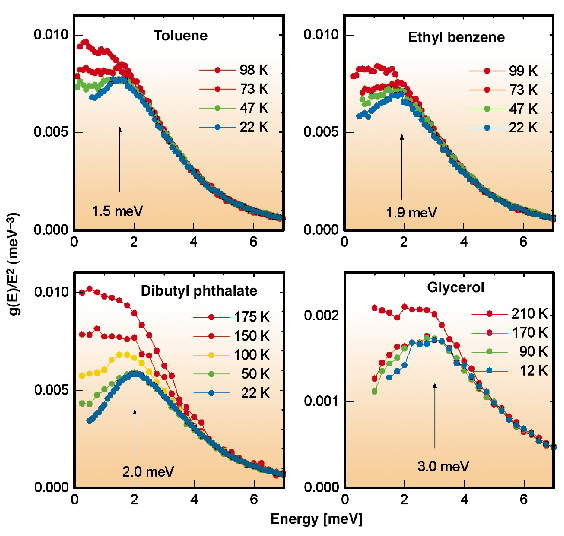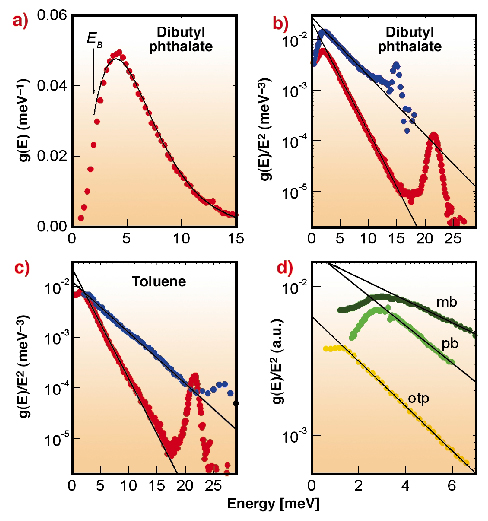- Home
- Users & Science
- Scientific Documentation
- ESRF Highlights
- ESRF Highlights 2004
- High Resolution and Resonance Scattering
- Universal Dynamics of Glasses
Universal Dynamics of Glasses
The dynamics of glasses is considered to be more complicated than that of crystals. In some sense this is surprising, because order may have an infinite variety of forms whereas chaos should be universal. The universal trends of disorder, however, are obscured by particular molecular properties. Disregarding such molecular modes and focusing exclusively on collective vibrations, we found a universal law for the high-frequency vibrations in glasses.
In order to measure only the collective motions, we studied the glass dynamics using probe molecules. When the probe "swims" in a glass matrix without coupling to the host molecules, it follows the collective motions of the glass but is not sensitive to the local modes of the host molecules.
The isotope-selective technique of nuclear inelastic scattering was used to monitor the motions of the probes, which were molecules with a resonant nucleus in the centre of mass. With this approach, one monitors exclusively the motions of the central resonant nucleus. Furthermore, one selects pure translational motions of the probes: rotation is disregarded because the spectator nucleus is in the centre of mass; the few intra-molecular modes are separated in energy. The selected pure translational motions of the probe give the "density of states of collective motions" (CDOS) of the glass matrix.
We investigated toluene, ethyl benzene, dibutyl phthalate, and glycerol glasses. The probes were ferrocene molecules with the central resonant 57Fe nucleus for the three first glasses and 57Fe2+ ions for glycerol. The insensitivity of the probes to local vibrations is confirmed by comparison to the total DOS available from neutron data.
For all studied glasses, the reduced CDOS g(E)/E2 clearly exhibits an excess of low-energy modes, the so called "boson peak" (Figure 3). The positions of the peak are consistent with the boson peak energies in the total DOS from neutron scattering data. The temperature evolution of the boson peak shows the same features as observed with other methods. This clear manifestation of the boson peak in the CDOS proves that the boson peak in the total DOS is largely composed of collective modes.
 |
|
Fig. 3: Reduced DOS of collective motions in toluene, ethyl benzene, dibutyl phthalate, and glycerol glasses. Arrows indicate the energy of the boson peak estimated from the data at the lowest temperature. |
Beyond the boson peak, the reduced density of states of collective motions reveals a temperature-independent exponential behaviour:
g(E)/E2~exp(-E/E0) , (1)
which, to our best knowledge, was not reported earlier. On a logarithmic scale, g(E)/E2 follows a straight line over three decades of the reduced CDOS and starts to deviate from Eq. 1 only when obscured by the eigen mode of ferrocene at 22 meV (Figures 4b-c). Such a large "dynamical range" allows a clear identification of the CDOS behaviour with Eq. 1.
 |
|
Fig. 4: (a) DOS of collective motions in dibutylphthalate at 22 K. Reduced DOS of collective motions in (b) dibutylphthalate and (c) toluene at 22 K ( |
We also found this exponential behaviour in the total DOS available from neutron data for all studied here and other glasses. The most evident examples are shown in Figures 4b-d. In toluene, for instance, the total DOS follows Eq. (1) in the energy range up to 22 meV and over two decades of g(E)/E2 (Figure 4c). In comparison to the total DOS, the CDOS exhibits slightly lower energy of the boson peak and a considerably steeper exponential slope. This difference can be explained by different correlation lengths accessible with various techniques.
In terms of fragility m, the studied glasses represent very fragile (toluene, m = 105), fragile (dibutylphthalate, m = 85), and intermediate (glycerol, m = 53) glass formers. The exponential behaviour of the reduced DOS is seen both in nuclear inelastic and inelastic neutron scattering data; it holds for molecular glasses, polymers, and proteins. These are strong indications that the exponential behaviour of the reduced DOS of collective motions is a universal feature for glasses.
References
[1] E. Duval et al, J.Non-Cryst.Sol. 307-310, 103 (2002).
[2] I. Tsukushi et al, J.Phys.Chem. Sol. 60, 1541 (1999).
[3] A. Tölle et al, Eur.Phys. J. B 16, 73 (2000).
[4] R. Zorn et al, Phys.Rev.E 52, 781 (1995).
[5] W. Doster, et al, Phys.Rev.Lett. 65, 1080 (1990).
Principal Publication and Authors
A.I. Chumakov (a), I. Sergueev (a,b), U. van Bürck (b), W. Schirmacher (b), T. Asthalter (c), R. Rüffer (a) O. Leupold (a,d), and W. Petry (b), Phys.Rev.Lett., 92, 245508 (2004).
(a) ESRF
(b) TUM Physik- E13, Garching (Germany)
(c) Univ. Stuttgart (Germany)
(d) HASYLAB, DESY Hamburg (Germany)



